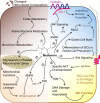The Aged Intestine: Performance and Rejuvenation
- PMID: 34631215
- PMCID: PMC8460310
- DOI: 10.14336/AD.2021.0202
The Aged Intestine: Performance and Rejuvenation
Abstract
Owing to the growing elderly population, age-related problems are gaining increasing attention from the scientific community. With senescence, the intestine undergoes a spectrum of changes and infirmities that are likely the causes of overall aging. Therefore, identification of the aged intestine and the search for novel strategies to rescue it, are required. Although progress has been made in research on some components of the aged intestine, such as intestinal stem cells, the comprehensive understanding of intestinal aging is still limited, and this restricts the in-depth search for efficient strategies. In this concise review, we discuss several aspects of intestinal aging. More emphasis is placed on the appraisal of current and potential strategies to alleviate intestinal aging, as well as future targets to rejuvenate the aged intestine.
Keywords: aging; bile acids; intestinal microbiota; intestine; short-chain fatty acids.
copyright: © 2021 Wang et al.
Figures



References
-
- Verdin E (2015). NAD+ in aging, metabolism, and neurodegeneration. Science, 350:1208-1213. - PubMed
-
- Bárcena C, Valdés-Mas R, Mayoral P, Garabaya C, Durand S, Rodríguez F, et al.. (2019). Healthspan and lifespan extension by fecal microbiota transplantation into progeroid mice. Nat Med, 25:1234-1242. - PubMed
Publication types
LinkOut - more resources
Full Text Sources
